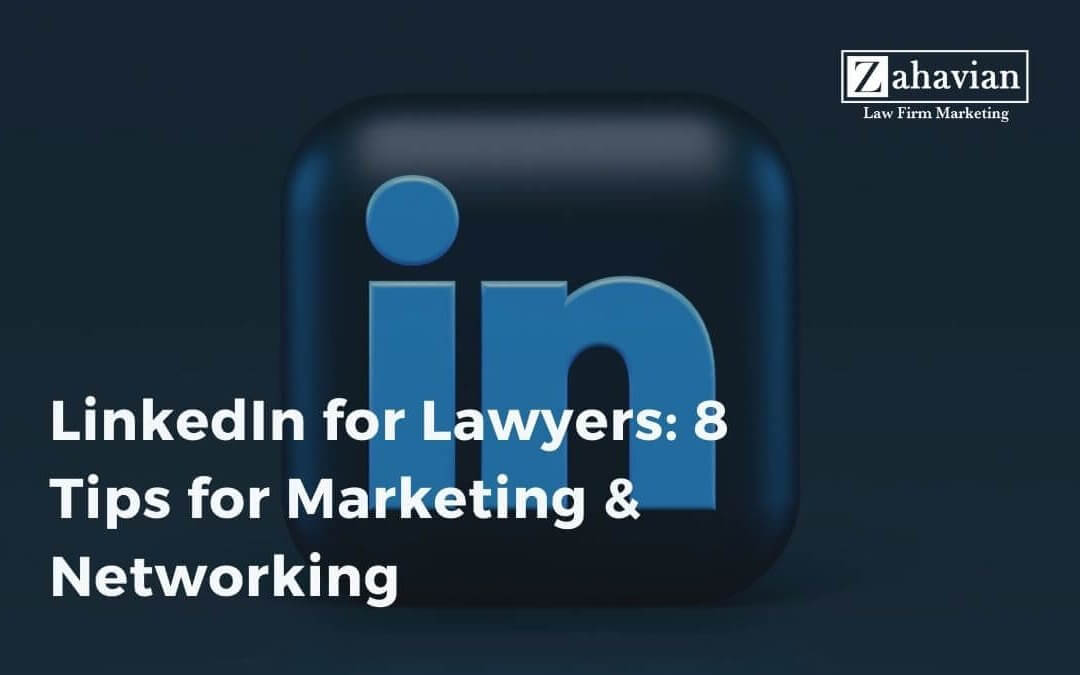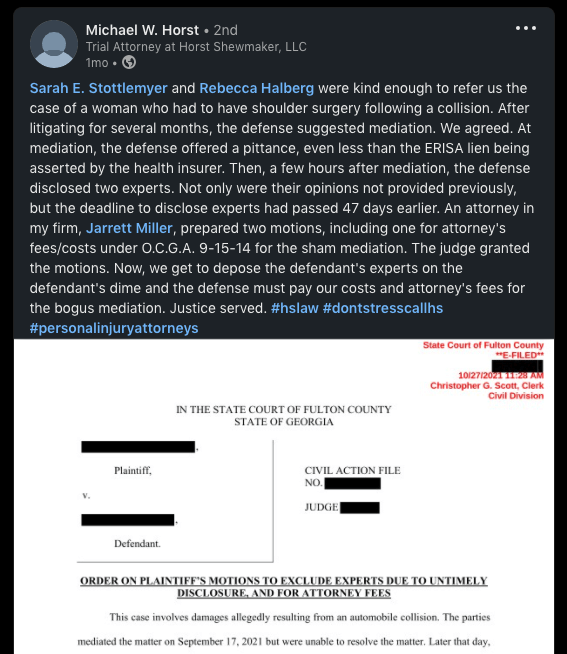When it comes to using social media to grow a law firm, most attorneys see Facebook as the go-to option. And yes, Facebook is great to engage with your audience. But have you ever wondered if lawyers need LinkedIn?
A survey estimates that 68% of people with a LinkedIn account were likely to use this platform to find a lawyer, and 94% would use it to research an attorney they were referred to. So, based on this, if you’re not using LinkedIn, you may be missing a huge marketing opportunity.
For that reason, in this article, I’ll provide you with some tips that can help you make the most of your LinkedIn profile. Here is a quick overview of the things that we’ll go over:
- Optimize your Profile
- Be Active and Share Content
- Build your Network
- Learn How to Use Hashtags
- Join or Create Groups
- Share Notable News about your Firm and Cases
- Drive Visitors to your Website
- Repurpose your Popular Website Content in a Post
Let’s get started!
1. Optimize your Profile
As you may already know, LinkedIn is more business and professional oriented than other social media platforms. Since your profile is like your digital business card, your information should be as accurate and complete as possible.
So, you should periodically review your LinkedIn lawyer profile to look for opportunities to improve, update, and optimize your copy writing and information. Yes, this can feel like another minor task to do, but it can have a profound impact on delivering your marketing message.
When optimizing your LinkedIn profile to make you stand out as a lawyer, make sure to:
- Write a descriptive and compelling professional headline.
- Write a “human” summary section where you describe your services, values, skills, etc.
- Upload a professional and recent headshot (or logo if the profile is for your law firm).
- Complete the education and experience section with relevant information.
- Add some personal and professional interests.
- Get some recommendations or endorsements from your colleagues.
- Include relevant awards.
- Mention groups or associations that you belong to.
- Add a clear call to action so people know how they can reach you.
The objective of optimizing your profile is to find opportunities to improve your information so people know what you can do to help them.
2. Be Active and Share Content
Users engage in social media through different types of content. LinkedIn for lawyers is no different. So if you’re going to use this platform to promote your law firm, you want to share content that adds value to your audience and helps you build your expertise.
The goal of this activity is to give people an idea of who you are and what you do. At the end of the day, the things that we publish or share say a lot about ourselves, right? So, although most of your content is going to be related to the law, you can also include more personable posts.
Some examples of content that you can share on LinkedIn includes:
- Legal news and updates related to your area of practice.
- Photos from goodwill events or non-profits in which you took part.
- Case wins, settlements, verdicts or other examples of law firm’s success stories.
- Resources that you have created to help people: blog posts, videos, webinars, ebooks, infographics, etc.
Just like any other social media platform or content marketing strategy, you want to be as active and consistent as possible. So, even though you don’t need to publish every day, you should try to follow some sort of schedule.
Pro Tip: Ideally, you want to create your own content, but you can also share some of your contact’s posts as long as they’re relevant to your profile.
3. Build your Network
As you may already know from your own practice, referrals are a good source of clients for law firms. And your LinkedIn lawyer profile is an excellent way to leverage or grow your referral sources.
You can start by connecting with colleagues, past clients, friends and other people that may be interested in your services. Additionally, you can use LinkedIn Advanced Search to look for clients or groups that fit within your area of expertise.
For example, if you’re an environmental lawyer, you can look to connect with organizations that also deal with this type of topic. Of course, you can check LinkedIn suggestions and see if there’s someone that you want to network with.
Before you start connecting with people, you should customize your request to make it more relevant and personal for the prospect that you’re trying to network with.
Pro Tip: Make sure your profile is complete and clearly states what you do and to whom you help. That way, your network understands the type of work that you do.
4. Use Hashtags
Just like other social media platforms, LinkedIn users can also add hashtags to their posts. If you want your posts to gain more visibility and exposure, then, you should use hashtags in your posts.
Although they may seem irrelevant, hashtags are used to:
- Categorize content by topics
- Help users to discover and search for content they’re interested in
- Establish your credibility and expertise
So, this can help your potential audience to find your posts. Check out what I found when I searched for #personalinjuryattorneys:
Helpful, isn’t it?
When it comes to LinkedIn for lawyers, use hashtags that are related to your area of expertise. Additionally, you should place them at the end of your content so they don’t interfere with the reading.
Pro Tip: If you don’t know which hashtags to use, you can go to the LinkedIn search bar to look for ideas. You can also create your own based on your main keywords.
5. Join or Create Groups
An easy way that attorneys can stay active and build their credibility on LinkedIn is by joining or creating groups that are relevant to their area of practice. Check this DUI Defense in Georgia. The purpose of the group is clear: discuss DUI laws in Georgia.
If you were a lawyer in this location, this group would be perfect to share content, answer people’s questions or brainstorm ideas for your own posts. Also, by providing useful information in these types of groups, people can start seeing you as an expert and the go-to person in your field.
Although you can look for existing groups on LinkedIn, your law firm can create and moderate its own group. In fact, the example that I provided you is a group created by a DUI attorney.
6. Share Notable News about your Firm and Cases
Many attorneys struggle to come up with ideas for their posts. This can be a challenging task, indeed. However, lawyers are always working on interesting legal matters and solving their inherent challenges.
Where am I going with this?
For lawyers, LinkedIn is a good place to share what’s going on in high-profile or newsworthy cases. If you or your law firm is tackling a legal challenge in a case, perhaps, your network will be interested in knowing more about it.
Again, this is another way to position yourself as an expert in your area of practice. In this case, one of the best opportunities you can take advantage of is when a well-established source or authority is giving you professional praise.
If you’re a top-notch litigator – and that’s what you want to be known for – then make sure to bookmark and share your praise on high with your network and fellow attorneys.
What better self-promotable opportunity could you ask for than having the highest court in all the land quoting you?
7. Drive Visitors to your Website
So far, we’ve established that LinkedIn is a great opportunity to establish yourself as an expert in your field and to grow your network. But, besides this, your law firm’s LinkedIn profile is also a good way to drive visitors to your website.
This can be done by simply making sure that your basic information has a link to your law firm’s website. Additionally, if you already have a piece of content that can be useful for your audience, you can write a small introduction on a LinkedIn post, add a link to that page and share it with your audience.
Which brings me to my next point.
8. Repurpose your Popular Website Content in Posts
Let’s face it, people on social media don’t want to be constantly led off of their social feeds to other websites. After all, they’re on the platform for one reason or another. Additionally, LinkedIn limits the number of people your post can reach if it contains links in it.
Why?
Because they want to increase the time that users spend on their platform, not decrease it. So, an alternative strategy to getting people to visit your website is to rewrite or repurpose content that you already have on your website into a native LinkedIn post.
All you have to do is rewrite content from a blog post or article that your firm published on its site and then rewrite it with a new spin or angle on LinkedIn. An advantage of doing this is that, if your article is evergreen, you can take different angles and publish different posts.
Take this very article that you’re reading as an example. I could take all the strategies and discuss them in a single post. Alternatively, I could publish each strategy, which would result in 9 posts instead of one.
This is actually great because it gives me the chance to add new ideas and approaches for each strategy. Or maybe I can add something new that I didn’t think about before or I can find better words to explain my point.
In short, repurposing your content gives you the chance to explore new angles that may be more attractive for your audience.



